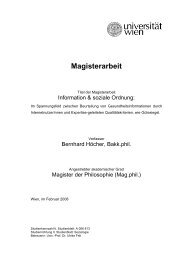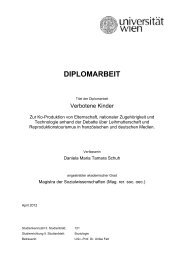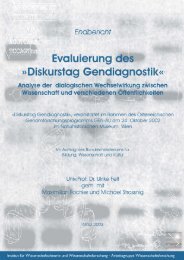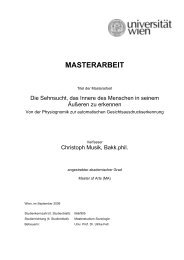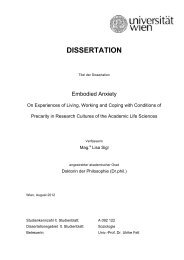MASTERARBEIT - Institut für Wissenschaftsforschung - Universität ...
MASTERARBEIT - Institut für Wissenschaftsforschung - Universität ...
MASTERARBEIT - Institut für Wissenschaftsforschung - Universität ...
Create successful ePaper yourself
Turn your PDF publications into a flip-book with our unique Google optimized e-Paper software.
4.3 tying together sociotechnical imaginaries and scot 35<br />
defined in detail, by all means they share something. The founding<br />
fathers of SCOT, Pinch and Bijker acknowledge this:<br />
»The key requirement is that all members of a certain social<br />
group share the same set of meanings, attached to a<br />
specific artefact. In deciding which social groups are relevant,<br />
the first question is whether the artefact has any<br />
meaning at all for the members of the social group under<br />
investigation.« [40, 414]<br />
Later, Bijker continues to stress the influence not only by the groups<br />
and their shared influence on the invention process itself, but by a<br />
much more subtle influence. Since inventors are themselves socialized<br />
human beings, their origin and socializations may manifest itself<br />
in the technological artifacts they build all by themselves.<br />
»The characteristics of these individuals, however, are also<br />
a product of social shaping. Values, skills, and goals are<br />
formed in local cultures, and we can therefore understand<br />
technological creativity by linking it to historical and sociological<br />
stories« [2, 4]<br />
However, this perspective is a one way street. It is all about preexisting<br />
social groups showing interest in an artifact. Just as well, the<br />
relevance can be expressed by a lack of interest. The fate of unsuccessful<br />
innovations is often not decided by interested groups but by<br />
targeted social groups not finding »any meaning at all« [see above]<br />
for an artifact. In the case of Zeppelin airships, history would not<br />
have become so complicated if those targeted with the artifact had<br />
accepted it from the beginning. As mentioned, the Prussian military<br />
administration did not acknowledge or even recognize the potential<br />
of count Zeppelin‘s invention. It was simply too fantastic. The second,<br />
more crucial critique I want to raise is the point that existing<br />
social groups are said to be interested (or not) in an artifact. This<br />
clearly implies a solely unidirectional influence of the social onto the<br />
technical: existing social structure influences the fate of technological<br />
development. It could, however, be much different. The relevant social<br />
group could just as well form around a shared interpretation of<br />
an artifact. This interpretation (or imaginary) can just as well serve as<br />
constituting element of a social group that evolves due to its positioning<br />
towards an emerging technology. It has to be stated that at least<br />
a potential of the technical development to influence social structure<br />
has to be acknowledged. It would be naive to state otherwise, as brief<br />
thought allows coming up with many examples of technologies having<br />
had heavy influence on the development of social structure. And<br />
even though SCOT is called social construction of technology, not technological<br />
construction of the social, the possibility of the game being<br />
played the other way round should at least be mentioned. Other theories<br />
have managed this point with a less unidirectional conception.



